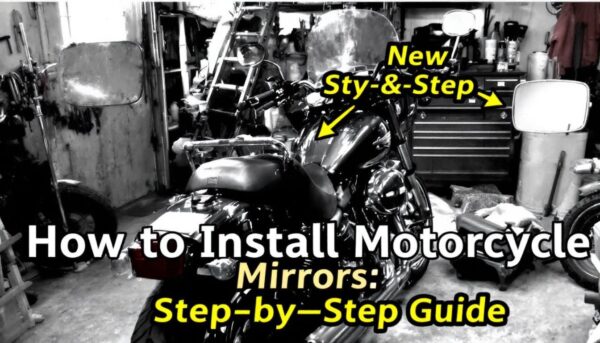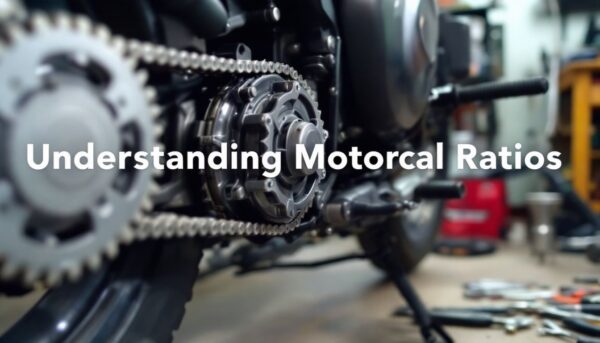
How to Maintain Your Motorcycle’s Cooling System Effectively
Keeping your motorcycle’s cooling system in top shape is key to a smooth ride. If the system fails, you might face engine overheating. This can lead to bigger problems down the road.
One important thing to know is that using the right coolant for your motorbike, as stated in the manual, makes a big difference.
This article will give you easy steps on how to maintain your motorcycle’s cooling system effectively. You’ll learn about regular checks, changing coolant, and more tips to prevent overheating.
By following these guidelines, you can take good care of your bike’s engine temperature.
Get ready for a cooler ride!
Key Takeaways
- Check your motorcycle’s cooling system often, including the coolant level before each ride. Change the coolant at least once a year or as often as you ride.
- Use the right type of coolant for your bike as stated in the owner’s manual to prevent engine overheating.
- Clean the radiator and remove any blockages to ensure good airflow and cooling efficiency.
- Install an EGT sensor to monitor your engine’s temperature closely, helping with early troubleshooting of issues.
- Get professional servicing for your motorcycle’s cooling system regularly to catch problems that you might miss.
Importance of Regular Cooling System Maintenance
Regular cooling system maintenance is key to keeping your motorcycle running well. This system helps regulate engine temperature and prevents overheating. An EGT sensor lets you monitor your engine’s heat, ensuring it stays within a safe range.
Setting up the carburetor properly also ensures the correct fuel-air mixture for optimal cooling.
Checking your coolant level before each ride is vital. You should change the coolant at least once a year, or based on how often you ride. Using the right coolant specified in your owner’s manual helps maintain proper motorcycle coolant system maintenance.
Regular checks and changes can improve engine performance and prevent costly repairs down the line.
Tips for Maintaining Your Motorcycle’s Cooling System
Check your motorcycle’s cooling system often. This helps catch small issues before they become big problems.
Regular inspectionRegular inspection is key for your motorcycle’s cooling system maintenance. Look at the coolant level before every ride. Ensure it meets the recommended level in your owner’s manual.
Check for leaks around hoses and fittings. A leak can lead to engine overheating if not fixed.
Inspect the radiator regularly, too. Clean any dirt or debris that may block airflow. This will help improve engine cooling efficiency. An EGT sensor can help you monitor engine temperature during rides.
It gives you quick feedback on how well your cooling system works.
Change the coolant at least once a year, or as needed based on your riding habits. Proper coolant use helps prevent motorbike engine overheating and keeps temperatures stable during rides.
Keeping these checks in mind ensures better overall performance and safety for your bike.
Advanced maintenance
Advanced maintenance helps keep your motorcycle running cool. Install an EGT sensor to track the temperature of the engine. This tool gives you real-time data, helping in engine cooling.
Set up your carburetor correctly for the best fuel-air mixture. Doing this improves engine performance and prevents overheating. Always use the right coolant, as listed in your owner’s manual.
Change it at least once a year or based on how often you ride. Change your engine oil regularly too; this keeps everything well-lubricated and cool.
Look for ways to increase flow through your cooling system. More flow can help with heat dissipation and stop overheating issues. Upgrading radiators can also boost cooling capacity significantly.
Next, explore key features of motorcycle cooling systems and best practices for their upkeep.
Upgrading the cooling system
Upgrading your motorcycle’s cooling system can greatly improve engine performance. Consider increasing the flow through the cooling system. This helps keep your engine at a safe temperature.
Enhancing radiator capacity is another smart move. It allows more heat to escape, reducing the risk of overheating.
Choose the right coolant for your bike as per your owner’s manual. Change it at least once a year or based on how often you ride. Regularly inspect the coolant level before each ride to ensure everything stays in check.
Installing an EGT sensor can also help you monitor engine temperature closely, which is crucial for effective maintenance of your motorbike’s cooling system.
Troubleshooting common issues
Troubleshooting common issues can save you time and money. It also helps keep your motorcycle running well.
- Check coolant levels: Inspect the coolant level before each ride. Low coolant can lead to overheating, so this is a simple but vital step.
- Look for leaks: Examine the hoses and radiator for any signs of leaks. A leaking cooling system can cause engine problems, so fixing it early is crucial.
- Inspect the radiator: Ensure there are no blockages in the radiator fins. Dirt or debris can limit airflow and affect cooling efficiency.
- Monitor engine temperature: Install an EGT sensor to keep an eye on your engine’s temperature. High temperatures may mean trouble, so take action if needed.
- Check the coolant colour: The colour of your motorbike’s coolant should be bright and clear, not muddied or brown. Change it if it looks dirty to maintain effective cooling.
- Adjust carburetor settings: Make sure your carburetor gives the right fuel-air mixture. A poor mixture can lead to overheating during rides.
- Change the oil regularly: Regularly changing motorbike oil keeps everything lubricated and cools the engine effectively.
- Increase cooling flow: Check if your cooling system has enough flow through it for better performance. More flow means better heat dispersion from the engine.
- Clean radiators often: Remove grime from radiators to increase their capacity for cooling effectively. Keeping them clean helps avoid overheating issues.
- Take breaks while riding: Allowing stops during longer rides enables your engine to cool down naturally, which prevents overheating during intense use.
Effective bike cooling system maintenance starts with troubleshooting these common issues and ensuring all parts work smoothly together.
Professional servicingProfessional servicing is vital for your motorcycle’s cooling system. Skilled mechanics can spot issues you might miss. They have the right tools and experience to keep your bike in top shape.
An EGT sensor helps track engine temperature. A mechanic will check this sensor and ensure proper setup of the carburetor. This step ensures a correct fuel-air mixture for optimal engine cooling.
You should change the coolant at least once a year or based on how much you ride. Professionals understand which is the ideal coolant for motorbikes as stated in your owner’s manual.
Regular oil changes also help maintain lubrication and cooling, boosting overall performance during long rides.
Key Features of Motorcycle Cooling Systems and Recommended Maintenance Practices
Motorcycle cooling systems come in different types, each with unique features. You must know how to choose the right coolant and use diagnostic tools for best results.
Types of cooling systems
Motorcycles use two main types of cooling systems: air-cooled and liquid-cooled. Air-cooled bikes rely on airflow to cool the engine. They have fins that help distribute heat. Liquid-cooled motorcycles use coolant to transfer heat away from the engine.
This type is often more efficient, especially during long rides.
With a liquid-cooling system, you need to keep an eye on the coolant level before each ride. Change the motorbike coolant at least once a year or based on your riding habits. Using special coolants for motorcycles will help prevent overheating and maintain proper engine temperature regulation.
Special coolants for motorcycles
Coolants play a key role in your motorcycle’s cooling system. They help keep the engine from overheating. It is crucial to use the right coolant as listed in your owner’s manual. Using the wrong type can lead to problems, so always double-check.
Special coolants for motorcycles often contain additives that protect against rust and corrosion. They also help improve heat transfer, which keeps your bike running smoothly. Change the coolant at least once a year or more based on how often you ride.
Always check your motorcycle’s coolant level before each ride. This simple act prevents overheating and ensures proper engine cooling. An EGT sensor can monitor engine temperature effectively, giving you peace of mind while riding.
Up next are some troubleshooting tips for common issues with cooling systems.
Utilising diagnostic tools for optimal maintenance (e.g. ANCEL MT700)
Using diagnostic tools helps you maintain your motorcycle’s cooling system. The ANCEL MT700 is a useful device for this. It can check the temperature of your engine and alert you if things get too hot.
Installing an EGT sensor will help you monitor the engine’s heat often.
Set up your carburetor correctly to mix fuel and air well. This setup aids in proper cooling of the engine as it runs. Ensure that you use the right coolant, as mentioned in your owner’s manual.
Choosing special coolants for motorcycles keeps everything running smoothly.
Regular checks on coolant levels are essential before each ride. Change your motorcycle coolant at least once a year or more often depending on how much you ride. Using tools like the ANCEL MT700 allows efficient troubleshooting of common issues, thus preventing motorcycle overheating effectively.
Conclusion
Maintaining your motorcycle’s cooling system is key for a smooth ride. Regular checks help prevent overheating and keep your engine running well. Change the coolant yearly and monitor levels before each trip.
Follow these tips to ensure your bike stays cool on the road. Enjoy every ride with confidence in your motorcycle’s performance!
FAQs
1. How can I prevent my motorcycle from overheating?
You can prevent your motorcycle from overheating by effectively maintaining the motorbike cooling system. This includes regular coolant flushes and ensuring that the engine cooling practices are followed.
2. What is involved in DIY motorcycle maintenance for the cooling system?
DIY motorcycle maintenance involves understanding your motorbike’s cooling system diagram, changing the coolant regularly, and servicing the cooling system to keep it running efficiently.
3. Why should I care about my motorcycle’s engine cooling?
Proper care of your motorcycle’s engine cooling helps in preventing overheating which could damage components and affect performance.
4. When should I perform a motorbike coolant flush?
The timing for a motorbike coolant flush varies depending on usage but generally, it’s good practice to change your bike’s fluid at least once every two years as part of ongoing motorbike engine care.
5. Can you tell me more about how a motorbike’s cooling system works?
A Motorbike’s Cooling System circulates fluid through pipes and passageways in the engine to absorb heat, then dissipates it away from the bike to maintain an optimal operating temperature.


